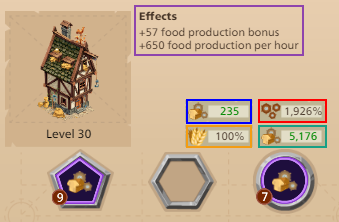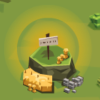Maximize food production

Food basics
Food is one of the main resources in the game. Food is used to feed your soldiers, so having a greater food production will allow you to hold more troops, hence allowing you to have more powerful attacks and also have a better defense for incoming attacks. In order to maximize your food production, you may go directly to the list of factors affecting food productivity or keep reading this article, which will give you a better underrating about the terms and options that are involved and have influence on food in the game.
Food Usage
Each soldier in any castle of outpost requires food to survive (this excludes mead soldiers that doesn't need food to survive, but to produce mead for them you need food). This value varies for each soldier, and it is usually 2-5 food units per hour.
- Food production - The total amount of food that can be produced in a castle or outpost per hour
- Food consumption - The total amount of food that all soldiers in a castle or outpost are consuming per hour
- Food usage - The value that is calculated from the two above, can be positive or negative
Here is the formula:
[ Food production ] - [ Food consumption ] = [ Food usage ]
If you produce more than you consume the "Food usage" is positive (black color). Similarly, if you consume more food than you produce the "Food usage" is negative (red color). This is the reason that one of your main goals while playing the game is to continuously increase your food production.
Negative food usage
When your "Food Usage" per castle/outpost is negative, it means that your soldiers are consuming more than you can produce, and in some point later in time they will starve (and you will lose them) if you don't do anything. In this case, you will see also for how many hours/days the amount of food you have can be sufficient for your soldiers. There are few ways to handle negative food consumption.
Here are some suggestions that can prevent your soldiers from starving:
- Loot food from NPC targets (e.g. "robber Barron Castles"), if you are planning to go off-line, you may make some of those attacks very slow (e.g. to distant targets & using slow tools), so you will get the food in a more slow pace, hence keeping your balance over time.
- Move some soldiers to another castle/outpost or to another kingdom
- Transfer food from another castle/outpost or from another kingdom
- Increase food productivity by replacing some decorations with higher level ones to achieve higher PO
- Increase your food storage to have more grace time for your soldiers
- Manually discharge (delete) some soldiers. This should be your last option, since you invested time/coins/rubies on those, so it is a pity to demolish them.
Food production
Buildings that produce food
Food is produced by 2 types for buildings: Normal buildings: Farmhouses, Granaries and relic buildings: Greenhouses and Conservatories. Relic food buildings has some advantages over the normal buildings, but you are limited to 4 relic building in total for every castle or outpost (2 x greenhouses and 2 x conservatories). Both provide similar production, but upgrading the greenhouses is much cheaper than the conservatory: A full upgrade of a greenhouses all the way to level 20 will cost you 120 construction tokens & 1,125 upgrade tokens, where a full upgrade of a conservatory will cost 1,875 construction tokens & 9,315 upgrade tokens. For this reason, you should upgrade your 2 x greenhouses first up to level 20, and only then start upgrading the conservatories.
Here are the main differences between normal food buildings (e.g. Farmhouses & Granaries) and relic food buildings (e.g. Greenhouses and Conservatories):
| Building Type | Upgrade materials | Benefits | Burn |
|---|---|---|---|
| Normal | Normal resources Kingdom resources | Food only | Yes |
| Relic | Construction tokens Upgrade tokens | Produce much more food than normal Public Order (PO) from level 16 Food storage capacity bonus from level 11 | No |
Food production workload
Every castle and outpost has a maximum number of buildings that can produce food at 100% workload. When you build more buildings than this number, their workload will be downgraded (75%, 56%, 42%, 31%, 23%, 17%, 13%, 10%, 7%, 5%, 3% and so on). As one of the major factors for food production is "Public Order" (PO), there should be a balance between the number of food production buildings and decoration items. Usually buildings that give you 5% of workload or less, should be demolished, so you save more space for decoration items to increase your PO, that will also increase the productivity for all higher (workload) buildings.
Here are the 100% workload building for each Kingdom:
| Kingdom | Castle Type | 100% workload food buildings |
|---|---|---|
| The Great Empire | Castle | 3 |
| The Great Empire | Normal outpost | 6 |
| The Great Empire | Shiny outpost | 8 |
| Everwinter glacier | Castle | 2 |
| Burning sands | Castle | 2 |
| Fire peaks | Castle | 2 |
| Storm Islands | Castle | 2 |
Calculating food productivity per building
Each and every food building follow 4 parameters that determine its total food productivity.
Is is called: "food per hour". Here is an example:

- Effects
Derived from build items in both primary & relic slots - Basic production
Depends on the building level & build items that have "food production bonus". Here we have a level 9 primary "base production build item" which gives "+57 food production bonus" - Workload
Derived from the food production workload - Productivity
Depends on many factors that are described later - Food per hour
Is calculated based on those 4 parameters.
[ Basic production ] x [ Workload ] x [ Productivity ] + [ Effects ] = [ Food per hour ]
Here we have a level 7 "relic food production build item" which gives "+650 food production per hour"
In our example: 235 x 100% x 1926% + 650 = 5176
"Shiny" outposts
 Every outpost has 2 resources that can be produced, primary & secondary. Those consist of food (always) and wood or stone (but there is no wood + stone outpost). Normal outposts have their primary resource with a workload of 6 and the secondary resource with a workload of 2. However, some of the outposts you find on the map, have a "glowing aura" around them. Those are called "shiny outposts" and have a workload of 8 on their primary resource. For novice players that are in early stage for the game, It is highly recommended choosing "shiny outposts" with a food as primary resource. This will give you the ability to have 8 food buildings that has 100% workload. This "early in game" decision will have a huge impact on your later progress in the game.
Every outpost has 2 resources that can be produced, primary & secondary. Those consist of food (always) and wood or stone (but there is no wood + stone outpost). Normal outposts have their primary resource with a workload of 6 and the secondary resource with a workload of 2. However, some of the outposts you find on the map, have a "glowing aura" around them. Those are called "shiny outposts" and have a workload of 8 on their primary resource. For novice players that are in early stage for the game, It is highly recommended choosing "shiny outposts" with a food as primary resource. This will give you the ability to have 8 food buildings that has 100% workload. This "early in game" decision will have a huge impact on your later progress in the game.
Another advice for novice players: if you do not find 3 "shiny" outposts near your current location of your main castle in "The Great Empire", don't compromise on normal outposts and consider to re-locate your main castle to a place on the map that has 3 "shiny outposts" (with food as primary resource) nearby (!)
Factors affecting food productivity
Here are the factors that affect your food production. You have 2 types of effects: permanent (e.g. building, research) that does not change over time and therefore are temporary (e.g. titles, VIP mode, subscription) that might degrade over time or expire, hence needed to be kept active to have their influence.
permanent effects
- Public order (PO) - Has an enormous impact on food production (and on other resources as well). You may find more detailed information on how to increase your "Public Order".
- Flour mill - Gives +10% for each level up to 60% (level 6)
- Hunting Lodge - Will boost food production in 120-130%. It is highly recommended that you will have one in each castle/kingdom
- Core research - Complete the "Plow" research (level 3) to get +96 food production per hour in your main castle only
- Advanced research - Complete the "three-fields crop rotation" research (level 5) to get +20% productivity for all farmhouses, granaries & relic greenhouses in all your castles
- Coat of arms - By choosing some symbols for your coat of arms, you may further increase food production between +4% to +80% (by using the same symbol twice). This is however an expensive booster, since all those symbols (except the 1st one, "Fish" that cost 2,500 gold and gives +2%) need to be released by paying a considerable amount of rubies, makes it very difficult for non-ruby players.
- Castellan - Some relic (blue) castellans has a bonus "base resources production bonus". With 3 gold stars on that bonus, you may have +1,200 and higher value.
- Food "Resource Villages" (in kingdoms) - Those can boost food production up to +40% for each. In each kingdom the maximum number of food "Resource Villages" you can hold varies.
Temporary effects
Gallantry title - "the Widowmaker" (25,000 points) +20% higher food production in all kingdoms
Gallantry title - "Weapon maker" (95,000 points) +20% higher food production in the Great Empire
VIP mode - Can boost food production up to +30% (level 10)
Player subscription #1 - When bought, will boost food production in +10%
Hunting Lodge
 The Hunting Lodge is a (civil) building that can be build when you reach level 53. It increases the food production, but in parallel decreases the wood and stone production. If you attack many RBC targets & participate in events (e.g. Nomads, samurai, foreign lord) you may easily loot wood & stone from those targets, so it is highly recommended that you adjust your "Hunting Lodge" in all 4 kingdoms for the maximum food production.
The Hunting Lodge is a (civil) building that can be build when you reach level 53. It increases the food production, but in parallel decreases the wood and stone production. If you attack many RBC targets & participate in events (e.g. Nomads, samurai, foreign lord) you may easily loot wood & stone from those targets, so it is highly recommended that you adjust your "Hunting Lodge" in all 4 kingdoms for the maximum food production.
Building a "Hunting Lodge" (level 1) will cost you only wood & stone, but further upgrading it (up to the maximum level 3) will cost you rubies. The higher the level, the better ratio between food (increase) and wood & stone (decrease). There are two "flavors" of this building: in "The great Empire" it is called: "Imperial Hunting Lodge" and on other kingdoms it is called: "Campaign Hunting Lodge" (you can not build it on "Storm Islands"). When you build one (in your main castle in "the Great Empire") the adjusted food production will also reflect all your outposts. The "Campaign Hunting Lodge" has a slight (better) difference in ratio than the "Imperial Hunting Lodge".
| Lodge level | Cost | Exp. points | Imperial ratio | Campaign ratio |
|---|---|---|---|---|
| 1 | 29,900 wood 34,600 stone | 26 | 4:1 | 2.6:1 |
| 2 | 35,000 rubies | 55 | 3.5:1 | 2.3:1 |
| 3 | 48,000 rubies | 70 | 3:1 | 2:1 |
Food storage
 When you increase your food storage capacity, you will have more grace time for your soldiers. You can do that in two ways (in parallel):
When you increase your food storage capacity, you will have more grace time for your soldiers. You can do that in two ways (in parallel):
- Upgrading your Storehouse to maximum (level 8) will give you 100,000 food storage capacity.
- Having 4 x relic buildings and upgrade them to maximum (level 20). Those building will give you food storage bonus when reached to level 11. Having all 4 x relic buildings maxed to level 20 will give you an additional 80,000 food storage.
Those 2 will give together a total of 180,000 food storage (!)


Add a new comment for Maximize food production
5 comments
27 Oct 2025 14:30
nwHl
05 Nov 2025 12:24
katana
02 Apr 2024 17:13
Why is the food production in all kingdoms frozen, and at zero production. I was on fire the pass few days.
30 Nov 2025 23:03
katana
26 Jun 2022 10:45
Relic storehouse gives 50.000 extra food storage on lvl 5
30 Nov 2025 20:58
katana
24 Apr 2022 21:04
Merci.
07 May 2021 16:33
NO NEED TO UPGRADE THE HUNDTING LODGE, IT'S JUST A WASTE OF RUBIES!
27 Oct 2025 14:31
lYSK
05 Nov 2025 20:25
katana
30 Nov 2025 19:18
katana